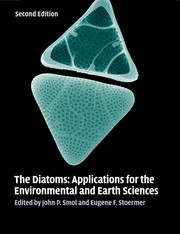Book contents
- Frontmatter
- Contents
- List of contributors
- Preface
- Part I Introduction
- Part II Diatoms as indicators of environmental change in flowing waters and lakes
- Part III Diatoms as indicators in Arctic, Antarctic, and alpine lacustrine environments
- Part IV Diatoms as indicators in marine and estuarine environments
- 15 Diatoms and environmental change in large brackish-water ecosystems
- 16 Applied diatom studies in estuaries and shallow coastal environments
- 17 Estuarine paleoenvironmental reconstructions using diatoms
- 18 Diatoms on coral reefs and in tropical marine lakes
- 19 Diatoms as indicators of former sea levels, earthquakes, tsunamis, and hurricanes
- 20 Marine diatoms as indicators of modern changes in oceanographic conditions
- 21 Holocene marine diatom records of environmental change
- 22 Diatoms as indicators of paleoceanographic events
- 23 Reconsidering the meaning of biogenic silica accumulation rates in the glacial Southern Ocean
- Part V Other applications
- Part VI Conclusions
- Glossary, acronyms, and abbreviations
- Index
- References
22 - Diatoms as indicators of paleoceanographic events
from Part IV - Diatoms as indicators in marine and estuarine environments
Published online by Cambridge University Press: 05 June 2012
- Frontmatter
- Contents
- List of contributors
- Preface
- Part I Introduction
- Part II Diatoms as indicators of environmental change in flowing waters and lakes
- Part III Diatoms as indicators in Arctic, Antarctic, and alpine lacustrine environments
- Part IV Diatoms as indicators in marine and estuarine environments
- 15 Diatoms and environmental change in large brackish-water ecosystems
- 16 Applied diatom studies in estuaries and shallow coastal environments
- 17 Estuarine paleoenvironmental reconstructions using diatoms
- 18 Diatoms on coral reefs and in tropical marine lakes
- 19 Diatoms as indicators of former sea levels, earthquakes, tsunamis, and hurricanes
- 20 Marine diatoms as indicators of modern changes in oceanographic conditions
- 21 Holocene marine diatom records of environmental change
- 22 Diatoms as indicators of paleoceanographic events
- 23 Reconsidering the meaning of biogenic silica accumulation rates in the glacial Southern Ocean
- Part V Other applications
- Part VI Conclusions
- Glossary, acronyms, and abbreviations
- Index
- References
Summary
Introduction – the importance of pre-Quaternary diatoms in paleoceanography
The marine system is vast, involving a highly diverse range of habitats; from coastal lagoons, fjords, bays, and estuaries, out over the shelf to the open ocean thousands of kilometers from any landmass. The Pacific Ocean alone covers an area of nearly 170 million km2. In total, the world's oceans cover approximately two-thirds of the Earth's surface and since marine diatoms are the dominant marine primary producers, contributing about 40% of the total primary production in the modern oceans (Tréguer et al., 1995) and over 50% of organic carbon burial in marine sediments (Falkowski et al., 2004), they are key players in the marine biological carbon pump. Therefore, the study of both living and fossil marine diatoms is important for many reasons other than just their intrinsic interest – from understanding (past) marine ecological systems, through biogeochemical cycling, to links with carbon dioxide (CO2) (e.g. Harrison, 2000), and the causes and effects of rapid climate change (e.g. Pollock, 1997).
Diatoms preserved in marine sediments are commonly used to reconstruct paleoenvironments and paleoceanographic events for the Holocene and Quaternary, but they are equally as valuable for paleoceanographic reconstructions of time periods much earlier than this – in fact for as far back as their fossil record allows, i.e. the Early Cretaceous (Gersonde & Harwood, 1990; Harwood & Gersonde, 1990).
- Type
- Chapter
- Information
- The DiatomsApplications for the Environmental and Earth Sciences, pp. 424 - 453Publisher: Cambridge University PressPrint publication year: 2010
References
- 7
- Cited by

